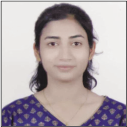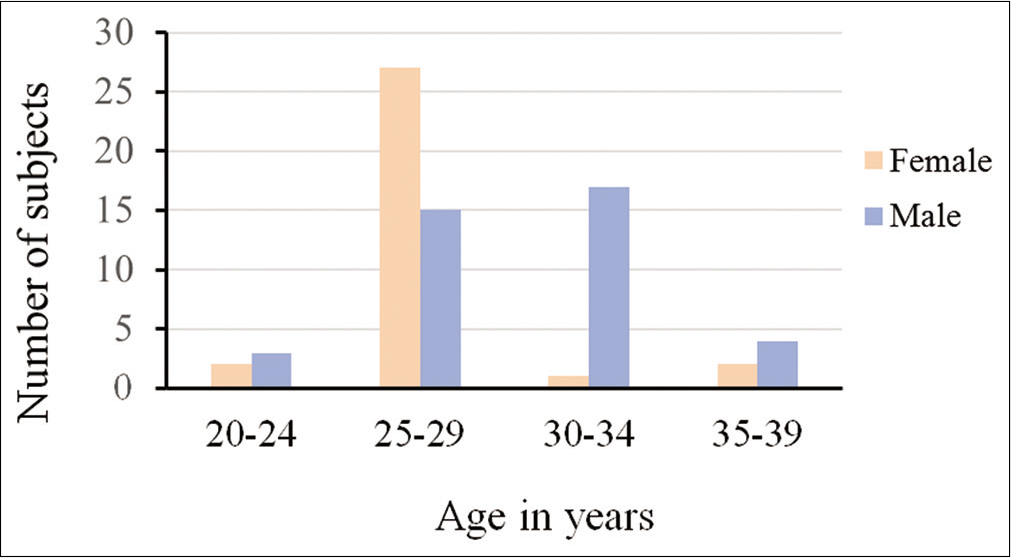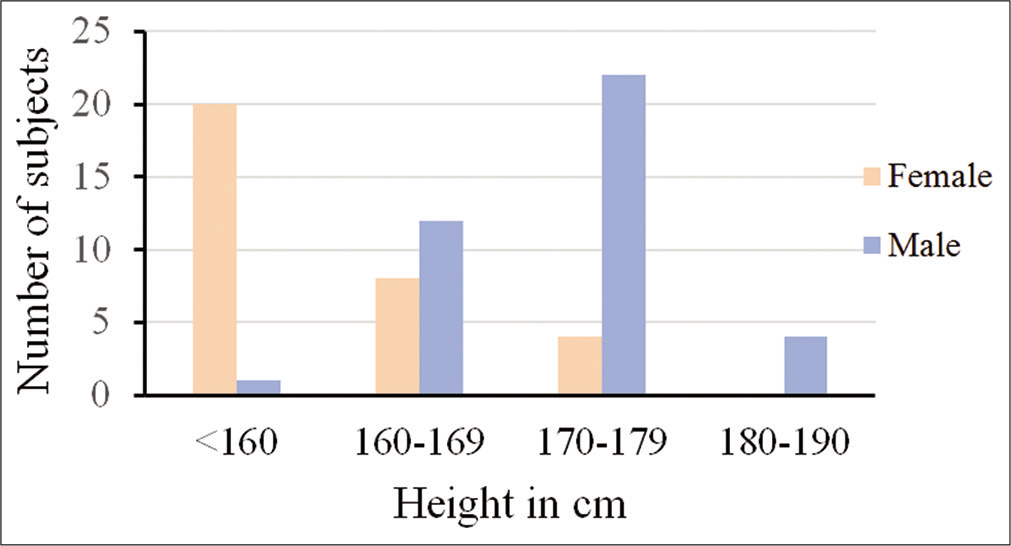Translate this page into:
Correlation of age, height, and gender with +Gz tolerance among healthy Indian participants

*Corresponding author: Dr S Kasture, MBBS, Resident in Aerospace Medicine, Institute of Aerospace Medicine IAF, Vimanapura, Bengaluru - 560017, Karnataka, India. shivani.kasture30@gmail.com
-
Received: ,
Accepted: ,
How to cite this article: Kasture S, Sharma M, Nataraja MS. Correlation of age, height, and gender with +Gz tolerance among healthy Indian participants. Indian J Aerosp Med 2020;64(1):14-7.
Abstract
Introduction:
Aircrew are repetitively exposed to positive Gz acceleration in fighter flying. Factors affecting +Gz tolerance vary among individuals and are determined by both modifiable and non-modifiable factors. Some of the non-modifiable factors influencing +Gz tolerance are age, gender, and height. The present study was undertaken to understand the relationship of these variables with relaxed +Gz tolerance.
Material and Methods:
The study involved a retrospective analysis of existing database of the high-performance human centrifuge at the Institute of Aerospace Medicine. Relevant data from 70 non-aircrew subjects were included for the study. Of these, 39 were male and 31 were female. The age and height varied from 27 to 38 years and 157 to 187 cm, respectively. The data were analyzed using Microsoft Office Excel® to find the correlation between age and height with relaxed +Gz tolerance. Relaxed +Gz tolerance of men and women was compared using unpaired t-test. Significance was set at P < 0.05.
Results:
The mean age, height, and relaxed +Gz tolerance of males were found to be 30.25 ± 4.3 years, 172.58 ± 6.5 cm, and 4.89 ± 0.67G, respectively, whereas those of females were 27.28 ± 3.36 years, 158.46 ± 6.78 cm, and 4.4 ± 0.85G, respectively. In both males and females, age and height showed no correlation with relaxed +Gz tolerance. However, the relaxed +Gz tolerance was found to be higher in males and this difference was statistically different (P = 0.008).
Conclusion:
Age and height showed no correlation with relaxed +Gz tolerance in both males and females nonaircrew subjects. Males exhibited a statistically significant, higher relaxed +Gz tolerance as compared to females.
Keywords
Relaxed Gz tolerance
High-performance human centrifuge
Age
Height
Gender
INTRODUCTION
Aircrew are exposed to various stressors in the flying environment. Acceleration is one such stressor, to which the fighter pilots are repeatedly exposed while performing Aerial Combat Maneuvers. Modern generation high-performance combat aircraft can expose the aircrew to a peak +Gz acceleration of 9G at an onset rate of 9G/s.[1] Pilots of modern fighter aircraft, who are unable to sustain these high-G loads, can get incapacitated due to G-induced loss of consciousness (G-LOC), resulting in mishaps.[2]
The physiologic effects of high-G stress include decreased head-level blood pressure due to hydrostatic pressure drop and decreased cardiac output due to inadequate venous return, resulting in symptoms of vision loss and finally G-LOC.[3] This drop in blood pressure is due to the hydrostatic column, approximately 30 cm, between the heart and the brain. This results in a 22–25 mmHg difference in blood pressure between heart and brain for every 1 +Gz to which the body is exposed.[4] During exposure to +Gz stress, typically, an individual progresses through a series of visual symptoms, including peripheral light loss (PLL) and central light loss, before progressing to G-LOC.[5] The body’s primary natural defense against the effects of G stress is cardiovascular baroreceptor reflexes and the neural tissue oxygen reserve, which determine the characteristic shape of the G-time tolerance curve.[6]
Human tolerance to +Gz acceleration can be assessed in a human centrifuge, both when relaxed and while straining. The gradual onset rate (GOR) run allows time for physiological reflexes, i.e. baroreceptor reflex to take effect and, in turn, increases arterial pressure which increases G level tolerance. A rapid onset rate (ROR) run does not provide such protection. For this reason, the relaxed GOR tolerance is found to be higher than relaxed ROR tolerance. The relaxed G tolerance is inherent to an individual.[5]
Acceleration tolerance of an individual may be influenced by certain modifiable factors including temperature, blood glucose concentration, alcohol, hyperventilation and hypoxia, distension of stomach, intercurrent infection, hydration, time off flying, preceding −Gz exposure, and some non-modifiable ones, such as gender, age, and anthropometric characteristics. The present study was conducted to find the correlation between non-modifiable factors such as age, height, gender, and relaxed +Gz tolerance of an individual. The assessment was considered necessary in the Indian Air Force (IAF) due to the following; (a) there is no stipulated limit for the age for fighter flying, (b) the present limitations of IAF permit aircrew with wide anthropometric ranges to fly fighter aircraft, and (c) IAF has recently inducted female aircrew in fighter flying.
MATERIAL AND METHODS
The study involved a retrospective analysis of the existing database of the high-performance human centrifuge (HPHC) at the Department of Acceleration Physiology and Spatial Orientation, Institute of Aerospace Medicine.
The data pertaining to 70 non-aircrew individuals were collected. Of these, 39 were male and 31 were female. Age, height, and relaxed +Gz tolerance of these subjects were taken from existing centrifuge run reports. The relaxed +Gz tolerance of these subjects was obtained by subjecting them to GOR acceleration of 0.1 G/s, while the subjects stayed relaxed in the centrifuge gondola until they had a PLL (56°–52°).
The collected data were subjected to descriptive and analytical statistical tests. Age, height, and relaxed +Gz tolerance of men and women were compared using unpaired t-test. Significance was set at P < 0.05. Further, correlations were drawn between age and height with relaxed +Gz tolerance in males and females using Pearson product-moment correlation. All graphs and statistical tests were done using Microsoft Office Excel® software.
RESULTS
The mean age, height, and relaxed +Gz tolerance were found to be 30.25 ± 4.3 years, 172.58 ± 6.5 cm, and 4.89 ± 0.67 G for males [Table 1] and 27.28 ± 3.3 years, 158.46 ± 6.78 cm, and 4.4 ± 0.85 G for females [Table 2]. The age and height distribution of male and female subjects are depicted in Figures 1 and 2, respectively. Males were taller and older than the female subjects and these differences were statistically significant (t = 3.16, P = 0.002 for age and t = 8.8, P < 0.001 for height).
| Males | Min. | Max. | Mean |
|---|---|---|---|
| Age (year) | 27 | 38 | 30.25±4.3 |
| Height (cm) | 152 | 187 | 172.58±6.5 |
| Relaxed+Gz tolerance (G) | 3.59 | 6.26 | 4.89±0.67 |
| Females | Min. | Max. | Mean |
|---|---|---|---|
| Age (Years) | 24 | 39 | 27.28±3.36 |
| Height (cm) | 153 | 176 | 158.46±6.78 |
| Relaxed +Gz tolerance (G) | 3 | 5.29 | 4.4±0.85 |

- Age distribution.

- Height distribution.
A statistically significant higher relaxed +Gz tolerance was observed among males as compared to female subjects (t = 2.71, P = 0.008). Pearson product-moment correlation did not reveal significant correlation between age (r = 0.28, n = 39, P = 0.075) and height (r = −0.28, n = 39, P = 0.08) with relaxed +Gz tolerance in males. Similarly, no significant correlation was observed between age (r = −0.13, n = 31, P = 0.4) and height (r = 0.08, n = 31, P = 0.63) and relaxed +Gz tolerance in female subjects.
DISCUSSION
Relaxed Gz tolerance, as compared to straining tolerance, represents the innate human response to the acceleration stress in standardized physiological and controlled laboratory conditions, without the complex interaction of uncontrolled variables. However, non-modifiable factors such as age, height, and gender have the potential of affecting relaxed +Gz tolerance. The present study intended to analyze the effect of these non-modifiable variables on relaxed +Gz tolerance. Many investigations have been conducted in the past to examine the same, but their conclusions have been largely inconsistent.
Relaxed +Gz tolerance most importantly depends on many cardiovascular factors. Resting blood pressure and peripheral vascular resistance are two such factors that are expected to increase with age, as a part of normal physiological aging processes (like vascular stiffening). These changes are also expected to have an effect on the relaxed +Gz tolerance of an individual. The results of the present study did not reveal any significant correlation between age and relaxed +Gz tolerance in males as well as females. Similar findings have also been observed in some previous studies by Swetleena[7] and Heaps et al.[8]. However, studies by Rai and Rao,[9] Singhal,[10] Whinnery,[11] and Burton[12] had predicted high relaxed +Gz tolerance among older pilots. The mean age of the subjects in our study was 30.25 ± 4.3 years, which represents a fairly young age group. This skewed age distribution in our sample compared to the large age variation in other studies could have been the reason for such a difference.
Hydrostatic pressure effects dictate that larger the hydrostatic gradient between the heart and brain, lower should the relaxed +Gz tolerance be. Hence, it was expected that with increase in height of the individual, there must be a corresponding increase between the distance between the heart and brain, thereby reducing G tolerance. In the present study, height showed no correlation with relaxed +Gz tolerance in either males or females. Similar findings have been documented in the previous studies of Malik,[13] Singhal,[10] and Avinash.[14] Cochran studied a total of 1000 individuals, where he found no effect of physical findings and living habits on G tolerance.[15] A study by the United States Air Force School of Aviation Medicine on 1434 fighter pilots concluded that prediction of G tolerance during centrifuge high-G training is unreliable using anthropometric and physiologic variables.[16] However, the finding is not in concurrence with other studies by Whinnery[11] and Burns[17] who concluded that shorter and heavier pilots had better +Gz tolerance. Possibly, the standing height may not be a reliable tool of heart-brain distance. Armpit to eye length used by Whinnery and Burns would be better predictors of heart-brain distance than standing height.[11,17]
The average stature of women in general population is expected to be lesser than males. This might have an increasing effect on relaxed +Gz tolerance, due to reduced hydrostatic gradient between heart and head. However, this beneficial effect may be offset by the lesser resting blood pressure observed in females compared to males. In our study, the relaxed +Gz tolerance of females was found to be significantly lower than that of males. Weighman et al.[18] and Gillingham et al.,[19] however, have reported no difference in relaxed +Gz tolerance between males and females. The difference in such a finding in our study could be due to non-inclusion of other important variables such as resting blood pressure, gastric filling, and blood glucose levels[3] in the analysis of the data. This was not feasible within the scope of the present study and is considered a limitation.
CONCLUSION
A retrospective analysis of the HPHC database involving 70 non-aircrew subjects revealed that relaxed +Gz tolerance of males was significantly greater than that of females. However, relaxed +Gz tolerance did not show any statistically significant correlation with age or height in the two different study groups i,e., males and females.
Declaration of patient consent
Participant’s consent not required as participant’s identity is not disclosed or compromised.
Financial support and sponsorship
Nil.
Conflicts of interest
There are no conflicts of interest.
References
- Analysis of multi-axis acceleration profile in a supermanoeuvrable aircraft. Indian J Aerosp Med. 2006;50:7-12.
- [Google Scholar]
- High-G stress and orientational stress: Physiologic effects of aerial maneuvering. Aviat Space Environ Med. 1988;59:A10-20.
- [Google Scholar]
- Long duration acceleration In: Rainford DJ, Gradwell DP, eds. Ernsting’s Aviation and Space Medicine (5th ed). London: Edward Arnold Publisher; 2016. p. :131-56.
- [Google Scholar]
- The hydrostatic pressures In: Gauer OH, Zuidema GD, eds. Gravitational Stress in Aerospace Medicine. Boston: Little, Brown and Company; 1961. p. :16-27.
- [Google Scholar]
- High G Physiological Protection Training. AMP Working Group No. 14, AGARDograph No. 322, 7 Rue Ancelle, 92200 Neurilly-Sur-Seine, France: SPS Printer Loughton. 1990.
- [Google Scholar]
- Human tolerance to positive G as determined by the physiological end points. J Aviat Med. 1956;27:356-67.
- [Google Scholar]
- A Study of the Relationship between Physical Fitness and +Gz Tolerance among Young Healthy Indian Women [MD Thesis] Bangalore: Rajiv Gandhi University of Health Sciences; 2010.
- [Google Scholar]
- Female acceleration tolerance: Effects of menstrual state and physical condition. Aviat Space Environ Med. 1997;68:525-30.
- [Google Scholar]
- Positive G tolerance of Indian subjects-effect of age and flying experience. Aviat Med. 1982;26:100-4.
- [Google Scholar]
- To Assess the Correlation of Physiological and Physical Parameters on Relaxed and Straining +Gz Tolerance [MD Thesis] Bangalore: Rajiv Gandhi University of Health Sciences; 2003.
- [Google Scholar]
- +Gz tolerance correlation with clinical parameters. Aviat Space Environ Med. 1979;50:736-41.
- [Google Scholar]
- Study on Physical and Physiological Characteristics of Fighter Pilots in Relation to their +Gz Tolerance [MD Thesis] Bangalore: Rajiv Gandhi University of Health Sciences; 1994.
- [Google Scholar]
- To Study the Relationship of Body Composition with Relaxed +Gz Tolerance in Indian Fighter Pilots [MD Thesis] Bangalore: Rajiv Gandhi University of Health Sciences; 2015.
- [Google Scholar]
- Variations in the Human G Tolerance to Positive Acceleration. Report No. USN/ SAM/NASA/NM-1-059.020.10. Pensacola, FL: US Navy; 1954.
- [CrossRef] [Google Scholar]
- Unpredictability of fighter pilot G tolerance using anthropometric and physiologic variables. Aviat Space Environ Med. 1991;62:128-35.
- [Google Scholar]
- Re-evaluation of a tilt-back seat as a means of increasing acceleration tolerance. Aviat Space Environ Med. 1975;46:55-63.
- [Google Scholar]
- The role of anaerobic power in human tolerance to simulated aerial combat maneuvers. Aviat Space Environ Med. 1995;66:938-42.
- [Google Scholar]






